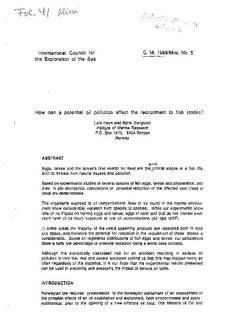How can a potential oil pollution affect the recruitment to fish stocks?
Working paper
Permanent lenke
http://hdl.handle.net/11250/104641Utgivelsesdato
1989Metadata
Vis full innførselSamlinger
Originalversjon
This report is not to be cited without prior reference to the authorsSammendrag
Eggs, larvae and the larvae's first search for food are the most critical stages in a fish life,
both to threats from natural causes and pollution.
Based on experimental studies of several species of fish eggs, larvae and zooplankton, and
their in situ abundance, calculations of potential reduction of the affected year class or
stock are demonstrated.
The organisms exposed to oil concentrations likely to be found in the marine environment
show considerably variation from species to species. While our experiments show
little or no impact on herring eggs and larvae, eggs of saith and cod do not tolerate even
short term (2-24 hour) exposure to low oil concentrations (50 ppb WSF).
In some areas the majority of the years spawning products are restricted both in time
and space, and therefore the potential for reduction in the recruitment of these stocks is
considerable. Based on registered distributions of fish eggs and larvae, our calculations
show a fairly low percentage of potential reduction using a worst case concept.
Although the statistically calculated risk for an accident resulting in serious oil
pollution is very low, real and severe accidents remind us that this may happen every so
otten regardless of the statistics. It is our hope that the experimental results presented
can be used in predicting and assessing the impact of serious oil spills.
